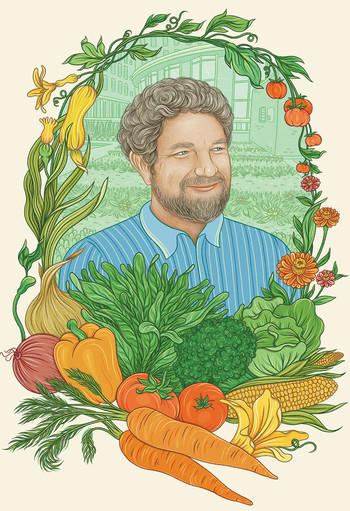Carrots! Collards! Broccoli! Morningside Heights' Secret (Vegetable) Garden
“I was born to be a farmer,” says Tommy Vaughan, surveying a row of bright-green shoots rising from the soil in a patch of land behind Uris Hall. The modest L-shaped plot, just steps from his office in the Schapiro Center for Engineering and Physical Science Research, has long served as an ad hoc student-run garden. But last spring, after the pandemic hit and the weeds took over, Vaughan, a professor of biomedical engineering and radiology who builds advanced MRI systems, decided to roll up his sleeves and start digging.
First he contacted Helen Bielak, operations manager of environmental stewardship, to get permission for his enterprise. Then he called Richard Bussert, director of landscaping and grounds, who provided new topsoil and tools and helped Vaughan dig and plant seeds for a small field of vegetables. Since then, Vaughan has raised carrots, corn, beets, turnips, collards, spinach, peas, lettuce, tomatoes, onions, squash, beans, peppers, kale, broccoli, and cucumbers, all harvested in the middle of a brick-and-limestone urban campus.
Planting is in Vaughan’s blood, and so is an appreciation for history. He was born and raised in Alabama, birthplace of some of the country’s most important agricultural innovations. And as his campus garden grew, and his gardening colleagues and random critters (some of them human) helped themselves to its bounty, Vaughan realized that he wasn’t just growing food: he was returning to his roots.
To that end, he named the plot the George Washington Carver Victory Garden, after America’s most famous agricultural scientist, who for nearly fifty years lived alone in a dormitory at the Tuskegee Institute (now University) in Tuskegee, Alabama. Born into slavery in Missouri, George Washington Carver developed sustainable-farming practices that helped rescue the South from disaster. “In the 1930s we had the Great Depression, the Dust Bowl, and the depletion of the soil due to decades of intensive cotton farming,” says Vaughan. “Cotton was the monoculture, and when a little insect called the boll weevil destroyed the cotton crop during the Depression, the South was in desperate need of crop diversification and soil conservation. Carver promoted new crops like peanuts and sweet potatoes that not only could be grown on the depleted soil but could also restore it.”
One farmer who embraced this revolution was Asa Vaughan Sr., Vaughan’s grandfather, who had a farm in Tuskegee and ran a seed store that supplied Carver with goods for his experiments. “Our family took a lot of pride in the relationship,” Vaughan says. Asa died before Vaughan was born, but when Vaughan was six his grandmother taught him how to plant vegetables in accordance with Carver’s principles of crop rotation and self-sufficiency.
Carver’s legacy also lives in the phrase “victory garden.” In March 1917, with the US at war and food being rationed, Charles Lathrop Pack formed the National War Garden Commission to encourage Americans to grow food at home for sustenance and morale. “Carver, an adviser to presidents and politicians, preferred the name ‘victory gardens’ to ‘war gardens,’” says Vaughan. It caught on. At the time of Carver’s death in 1943, at the height of another war, Americans, again facing rationing, had planted millions of victory gardens.
Though Vaughan knows the joys that come with a garden, he didn’t expect this one to draw visitors. But with fewer students around, the Morningside campus has blossomed into its alter ego of a public park: families stroll through, and it’s often the children who drag their parents to the garden’s edge. “We label the rows, so the kids know all the vegetable names. And whenever I’m out here weeding or watering, I assume the role of garden interpreter,” says Vaughan. “The kids are a wonderful audience.”
In his life on the other side of the pea trellis, Vaughan holds posts at Columbia Engineering, CUIMC, and the Zuckerman Mind Brain Behavior Institute. The eight to ten hours a week he spends in the campus garden doing “nice tedious, laborious work” provides respite from the lab and the classroom and brings him back to the basics.
“It’s huge therapy for me to dig in the dirt and plant things and watch them grow,” Vaughan says. “And it brings together two parts of my life. We’re honoring George Washington Carver here and connecting rural Alabama to a campus in the heart of Manhattan.”
This article appears in the Spring/Summer 2021 print edition of Columbia Magazine with the title "Magnetic Field."



